
The 1992 Pacific typhoon season had no official bounds; it ran year-round in 1992. Despite this, most tropical cyclones tend to form in the northwestern Pacific Ocean between May and November. These dates conventionally delimit the period of each year when most tropical cyclones form in the northwestern Pacific Ocean.

The 1988 Pacific typhoon season had no official bounds; it ran year-round in 1988, but most tropical cyclones tend to form in the northwestern Pacific Ocean between May and November. These dates conventionally delimit the period of each year when most tropical cyclones form in the northwestern Pacific Ocean. Tropical Storms formed in the entire west Pacific basin were assigned a name by the Joint Typhoon Warning Center. Tropical depressions that enter or form in the Philippine area of responsibility are assigned a name by the Philippine Atmospheric, Geophysical and Astronomical Services Administration or PAGASA. This can often result in the same storm having two names.

The 1987 Pacific typhoon season has no official bounds; it ran year-round in 1987, but most tropical cyclones tend to form in the northwestern Pacific Ocean between May and November. These dates conventionally delimit the period of each year when most tropical cyclones form in the northwestern Pacific Ocean. Tropical storms formed in the entire west pacific basin were assigned a name by the Joint Typhoon Warning Center. Tropical depressions that enter or form in the Philippine area of responsibility are assigned a name by the Philippine Atmospheric, Geophysical and Astronomical Services Administration or PAGASA. This can often result in the same storm having two names.

Typhoon Bess, was a powerful, deadly, and destructive tropical cyclone, which was the deadliest typhoon to hit Japan since Tip in 1979. The eleventh tropical storm, sixth typhoon, and first super typhoon of the 1982 Pacific typhoon season, the system first developed on July 21. Two days later, it was upgraded into a tropical storm, and subsequently began to intensify while tracking northwest. Bess attained typhoon intensity on July 24, before it briefly turned southwest. After turning north-northwest, the typhoon entered a period of rapid intensification and late on July 28 reached peak winds of 230 km/h (145 mph). After turning north, Bess began to weaken as it encountered less favorable conditions. On August 1, Bess was downgraded into a tropical storm. Shortly after that, the storm struck southeastern Japan, and on August 2 merged with a low pressure area atop of the Sea of Japan.
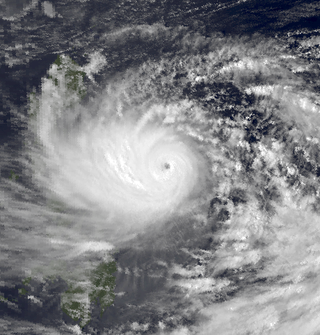
Typhoon Dot, known in the Philippines as Typhoon Saling, was the strongest storm of the 1985 season. Dot originated from a small area of thunderstorm activity in early to mid October. The system was first classified on October 11, and steadily intensified over the next few days. Dot attained typhoon strength on October 15, and subsequently entered a period of explosive deepening, which was not anticipated by forecasters. The next day the intensification rate slowed, but that evening, Dot attained its maximum intensify. A steady weakening trend began on October 17, though the system maintained typhoon intensity through the passage of the Philippines. After entering the South China Sea late on October 18, Dot briefly re-intensified, only to weaken as it approached Vietnam. On October 21, Dot struck Vietnam while still a typhoon, but dissipated the next day over the high terrain of the nation.
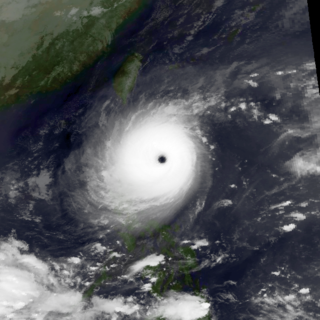
Typhoon Angela, known in the Philippines as Typhoon Rubing, was an intense tropical cyclone that formed in late September 1989. The storm developed from a tropical disturbance in the monsoon trough and moved generally westward throughout its duration. The storm ultimately peaked in intensity as a super typhoon and struck northern Luzon in the Philippines. After weakening and traversing the South China Sea, Angela bypassed Hainan to the south and struck Vietnam before dissipating. The storm caused severe damage and 119 fatalities in the Philippines. Thousands of houses were damaged, and hundreds of thousands of residents were impacted by the typhoon. Monetary damage is placed at $8 million.

Typhoon Andy, known in the Philippines as Typhoon Iliang, was an intense tropical cyclone that made landfall in Taiwan. Andy formed along the northern edge of the monsoon trough south of Guam on July 22, 1982. It became a tropical storm the next day, although this system was initially poorly organized. Andy moved steadily west during the first few days of its life. After looping south of Guam, the cyclone moved northwest and strengthened. Andy turned westward near the 18th parallel on July 25. The system became a strong typhoon for a prolonged period on July 27 and July 28 while attaining a peak intensity of 185 km/h (115 mph). However, the typhoon struck Southern Taiwan on July 29. Continuing westward through the Formosa Strait, the storm made its final landfall in southern China on July 30 and dissipated inland two days later.

Typhoon Judy, known in the Philippines as Typhoon Susang, was the third tropical cyclone to affect Japan during the 1982 Pacific typhoon season. Forming east of the Philippines in tandem with another system on September 4, the disturbance continued to intensify, and was upgraded into a tropical storm early on September 6 and a typhoon on September 8 while tracking northwestward. On September 9, Judy attained its peak intensity, with winds of 150 km/h (90 mph). Thereafter, increased wind shear took a toll on the typhoon, as it turned northward on September 11 in the general direction of Japan under the influence of a mid-latitude cyclone. Judy passed over southeastern Japan on September 12; by this time, the typhoon had weakened considerably. Judy became an extratropical cyclone almost immediately thereafter.

Typhoon Clara, known in the Philippines as Typhoon Rubing, left flooding in the northern Philippines and southern China during September 1981. An area of disturbed weather was first detected on September 11 near Ponape. After moving westward, the system gradually became better organized and thunderstorm activity increased. On September 16, the system attained tropical storm status. Two days later, Clara attained typhoon intensity and subsequently began to deepen at a faster rate. On September 19, Clara reached maximum intensity, before making landfall along the northern tip of Luzon. Clara steadily weakened after interacting with land, but by late on September 20, Clara leveled off in intensity over the South China Sea. The next day, Clara moved ashore to the east-northeast of Hong Kong while still at typhoon intensity before rapidly dissipating over land.

Typhoon Betty, known in the Philippines as Typhoon Herming, was a powerful and destructive tropical cyclone that struck the Philippines in August 1987. The seventh typhoon and second super typhoon of the active typhoon season, it formed from the monsoon trough that spawned a tropical cyclone on August 8 while around positioned well to the east of the Philippines. It drifted northwestward, becoming a tropical storm on August 9 and a typhoon on August 10. Betty turned westward, where it rapidly intensified before attaining peak intensity on August 11. The next day, Typhoon Betty made landfall in the central Philippines. Betty weakened rapidly over the country, but restrengthened somewhat over the South China Sea. Land interaction weakened Betty slightly before it hit central Vietnam on August 16. The next day, Betty dissipated.

Typhoon Wayne, known in the Philippines as Typhoon Katring, was an intense tropical cyclone that brought significant flooding to the Philippines in July 1983. The typhoon originated from an area of disturbed weather that formed far from land towards the end of July. Late on July 22, Wayne developed gale-force winds while moving west. The next day, it was estimated to have become a typhoon, and Wayne subsequently entered a period of rapid deepening. During the morning hours of July 24, the typhoon was estimated to have reached its peak intensity of 205 km/h (125 mph), but soon began to weaken due to interaction with land. By the time it moved ashore in southern China on July 25, Wayne had weakened considerably. After moving inland, Wayne weakened rapidly. The following day, Wayne was no longer a tropical cyclone.

Typhoon Nancy, known in the Philippines as Typhoon Weling, was a destructive typhoon that moved through Vietnam and the Philippines during October 1982. The typhoon originated from an area of convection and was first classified as a tropical cyclone on October 10. The system attained gale-force winds the next day, and slowly deepened thereafter. Although Nancy initially moved west, the system maintained a general westward course for much of its duration, striking Luzon on October 14 at peak intensity of 215 km/h (130 mph). It weakened to tropical storm strength overland, but re-intensified to typhoon intensity over the South China Sea. Nancy hit northern Vietnam on the October 18, and weakened almost immediately thereafter, before dissipating on October 20 inland over Vietnam.

Typhoon Mamie was the worst tropical cyclone to affect northeastern China in 26 years. Originating from an area of disturbed weather near the Philippines in mid-August 1985, the system gradually became better organized, and was upgraded into a tropical storm early on August 16. It continued to deepen, and late on August 17, Mamie attained typhoon intensity. Around this time, Typhoon Mamie reached its peak intensity of 120 km/h (75 mph), which it maintained for 12 hours. After making landfall in Shanghai, the storm steadily weakened. However, after turning north and crossing the Shanghai Peninsula and the Yellow Sea, Mamie made a second landfall near Yantai as a tropical storm. After turning northwest and re-entering the Yellow Sea, Mamie moved ashore for the third and final time near Dairen. On August 21, Mamie dissipated inland over northeastern China.
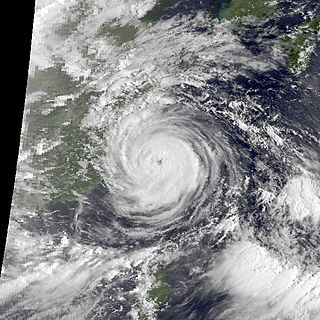
Typhoon Nelson, known in the Philippines as Typhoon Ibiang, was the worst tropical cyclone to affect Southern China in 16 years. Typhoon Nelson, which developed on August 16, 1985, originated from an area of thunderstorm activity well east of the Philippines. It gradually intensified over the next several days while moving northwest. Nelson reached typhoon intensity early on August 20 and two days later, attained peak intensity before turning west. The cyclone brushed northern Taiwan early on August 23 after weakening slightly. Nelson then briefly restrengthened to peak intensity. During the afternoon of August 23, it made landfall in eastern China before dissipating on August 25.

Typhoon Pat, known in the Philippines as Typhoon Luming, was a powerful typhoon that struck Japan during the summer of 1985. Pat is also one of three storms in the Western Pacific which interacted with each other. Originating from a monsoon trough towards the end of August, Pat first formed on August 24 several hundred miles east of the Philippines. It gradually intensified, and two days later, Pat was upgraded into a tropical storm. The cyclone initially moved east-northeast while continuing to deepen. However, Pat leveled off in intensity on August 27. After turning northwest, Pat attained typhoon intensity on August 28. Pat accelerated towards the north, and reached its peak intensity of 80 mph (130 km/h) on August 30. The next day, the storm crossed the southern Japanese islands and entered the Sea of Japan. Gradually weakening, Pat transitioned into an extratropical cyclone later on August 31. Early the next day, the storm moved ashore along northeastern Japan. The system dissipated on September 2 after reentering the Pacific Ocean. A total of 23 perished due to Typhoon Pat and 12 others were rendered as missing. Additionally, 79 people were injured. Furthermore, 38 houses in Japan were demolished, 110 were damaged, and over 2,000 were flooded. More than 160,000 homes lost power. A total of 165 flights were cancelled.
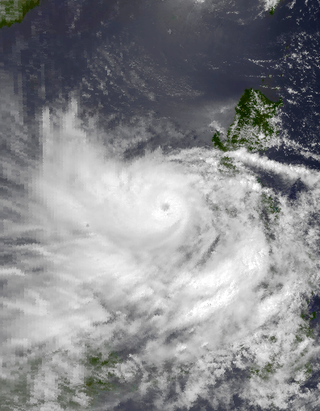
Typhoon Faye also known in the Philippines as Typhoon Norming was a long-lived typhoon that struck the Philippines in August 1982. On August 16, a weak tropical disturbance was moving towards the southern Philippines. Initially, land interaction with the Philippines with prevented significant development. After crossing the Philippines, the disturbance emerged into the South China Sea and increased in organization. It was upgraded into a tropical storm by midday on August 22. Thereafter, Faye began to steadily strengthen, and attained typhoon intensity later that day. On August 23, Typhoon Faye reached its peak intensity, which the storm would maintain for approximately 12 hours. A small cyclone, Faye moved northward on August 24 due to the weakening of a ridge over China. Thereafter, its center was disrupted by land interaction with the Philippines. As such, the storm weakened slightly before striking Luzon on the morning of August 25. Severe flooding and strong winds were recorded. More than 5,000 houses were damaged while 220,000 were homeless. Furthermore, around 7,000 people sought shelter. There were 18 injuries and 41 deaths in the Philippines. Overall, damage amounted to $9.6 million (1982 USD). Across Japan, two people perished.

Typhoon Kim, known in the Philippines as Typhoon Osang, was the second typhoon in a week to directly affect the Philippines during July 1980. Like Typhoon Joe, Kim formed from the near equatorial monsoon trough in the northwestern Pacific Ocean on July 19. The disturbance tracked quickly westward-northwest underneath a subtropical ridge, reaching tropical storm strength on the July 21 and typhoon strength on July 23. After developing an eye, Kim began to rapidly intensify, and during the afternoon of July 24, peaked in intensity as a super typhoon. Several hours later, Kim made landfall over the Philippines, but the storm had weakened considerably by this time. Throughout the Philippines, 40 people were killed, 2 via drownings, and 19,000 others were directly affected. A total of 12,000 homes were destroyed and 5,000 villages were flooded. Less than a week earlier, the same areas were affected by Joe; however, Kim was considered the more damaging of the two typhoons. Land interaction took its toll on Kim, and upon entering the South China Sea, the storm was down below typhoon intensity. Kim continued northwestward but its disrupted circulation prevented re-intensification, and it remained a tropical storm until hitting southern China July 27 to the northeast of Hong Kong, where only slight damage was reported. Later that day, Kim dissipated.

Typhoon Cary, known as Typhoon Ising in the Philippines, was the second of two tropical cyclones to affect Vietnam in a week. An area of disturbed weather developed southwest of Pohnpei on August 6, 1987. The system initially remained disorganized, but by August 14, Cary had attained tropical storm intensity. After initially moving north-northwest, Cary turned west-northwest, although intensification was slow to occur. On August 15, Cary was upgraded into a typhoon, and on August 17, the typhoon peaked in intensity. Typhoon Cary then made landfall in northern Luzon while at peak intensity. Across the Philippines, 954 houses were damaged and an additional 89 were destroyed, which left 55,567 people, or 13,247 families that were either homeless or otherwise sought shelter. Five people died in the country while damage totaled $5.58 million (1987 USD), including $1.45 million from agriculture and $4.13 million from infrastructure. The storm weakened over land, but re-intensified into a typhoon over the South China Sea. On August 21, Typhoon Cary passed just south of Hainan, where hundreds of homes were damaged but no fatalities occurred, and subsequently entered the Gulf of Tonkin. The storm weakened as it approached Vietnam, and on August 23, the storm dissipated inland over Laos. Across Vietnam, almost 40,000 ha of land were flooded or destroyed. Twenty people were killed and many others were injured.

Typhoon Irving, known in the Philippines as Tropical Storm Ruping, was a mid-season tropical cyclone that affected the Philippines and China during September 1982. An area of disturbed weather developed within the monsoon trough during early September 1982 near Guam. Following an increase in organization, a tropical depression developed on the morning of September 5. Later that day, the depression intensified into Tropical Storm Irving. Irving tracked westward, nearly becoming a typhoon before hitting the central Philippines. There, Irving uprooted trees, downed power and telephone lines, triggered landslides, and forced the cancellation of several domestic airline flights. Irving damaged 7,890 houses in Albay and Sorsogon provinces alone, resulting in 138,500 people homeless. Nation-wide, 65 people were killed, 26 others were hurt, and 29 were rendered missing. A total of 44,383 families or 248,040 residents sought shelter. Moreover, 18,488 homes were damaged and 5,599 others were demolished. Damage in the country was assessed at US$23.3 million, including US$14.2 million in crops. While crossing the island chain, Irving turned northwestward. After entering the South China Sea, Irving continued generally northwest, and became a typhoon on September 11. After developing a well-defined eye, Irving attained its peak intensity of 160 km/h (100 mph) the following day. Land interaction with Hainan Island resulted in a weakening trend, and Irving was downgraded to a tropical storm before striking the southern coast of China on September 15. Across the Leizhou Peninsula, 90% of homes were damaged. Onshore, Irving rapidly weakened and the storm dissipated on September 16.
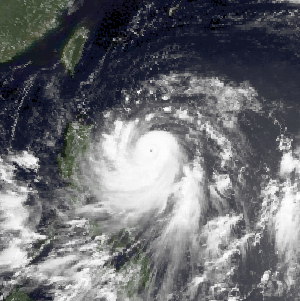
Typhoon Warren, known in the Philippines as Typhoon Huaning, struck the Philippines and China during July 1988. An area of disturbed weather developed within the vicinity of the Caroline Islands during the second week of July. A tropical depression developed southeast of Guam on July 12, and on the next day, intensified into a tropical storm. Tracking generally west-northwest, Warren deepened into a typhoon on July 14. The storm subsequently entered a period of rapid intensification, commencing with Warren reaching its highest intensity on July 16. The following evening, the typhoon brushed Luzon, resulting in a weakening trend, although Warren was still a typhoon when it made landfall near Shantou. Warren rapidly dissipated inland.





















